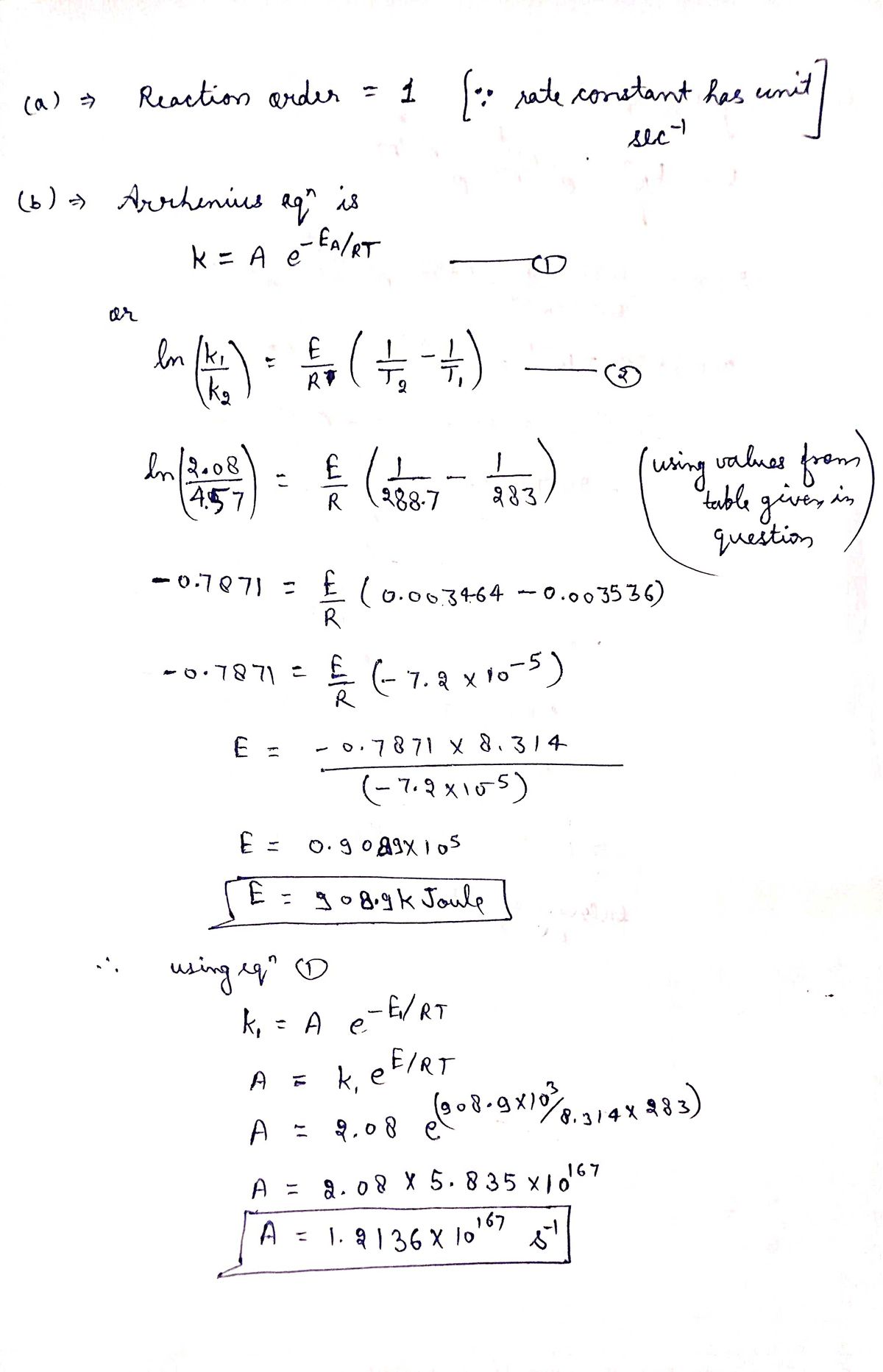6. The rate constant of the following second-order reaction of hydroxyl radical with 1,2- dichloroethane: OH(g) + CICH;CH,(g) → H20(g) + CIchCH;cl(g) was investigated experimentally and the following table was obtained TPC k/s a. What is the reaction order, why? b. Determine the Arrhenius parameters for this reactions c. Calculate the enthalpy, entropy, and free energy of activation at 298 K using Eyring equation for the transition complex (See page 338-343 Chapter 18 for part b and c 15.7 4.57 10.0 21.5 8.24 27.5 33.2 28.40 38.5 46.10 45.7 2.08 15.80 93.50
6. The rate constant of the following second-order reaction of hydroxyl radical with 1,2- dichloroethane: OH(g) + CICH;CH,(g) → H20(g) + CIchCH;cl(g) was investigated experimentally and the following table was obtained TPC k/s a. What is the reaction order, why? b. Determine the Arrhenius parameters for this reactions c. Calculate the enthalpy, entropy, and free energy of activation at 298 K using Eyring equation for the transition complex (See page 338-343 Chapter 18 for part b and c 15.7 4.57 10.0 21.5 8.24 27.5 33.2 28.40 38.5 46.10 45.7 2.08 15.80 93.50
Chemistry
10th Edition
ISBN:9781305957404
Author:Steven S. Zumdahl, Susan A. Zumdahl, Donald J. DeCoste
Publisher:Steven S. Zumdahl, Susan A. Zumdahl, Donald J. DeCoste
Chapter1: Chemical Foundations
Section: Chapter Questions
Problem 1RQ: Define and explain the differences between the following terms. a. law and theory b. theory and...
Related questions
Question

Transcribed Image Text:solve using excel and explain please
6. The rate constant of the following second-order reaction of hydroxyl radical with 1,2-
dichloroethane:
OH (g) + CICH,CH2(g) → H20(g) + ClIchCH;CI(g)
was investigated experimentally and the following table was obtained
TPC
k/s
a. What is the reaction order, why?
b. Determine the Arrhenius parameters for this reactions
c. Calculate the enthalpy, entropy, and free energy of activation at 298 K using
Eyring equation for the transition complex (See page 338-343 Chapter 18 for part
b and c
10.0
2.08
15.7
4.57
21.5
27.5
15.80
33.2
28.40
38.5
46.10
45.7
8.24
93.50
Expert Solution
Step 1

Step by step
Solved in 2 steps with 2 images

Knowledge Booster
Learn more about
Need a deep-dive on the concept behind this application? Look no further. Learn more about this topic, chemistry and related others by exploring similar questions and additional content below.Similar questions
Recommended textbooks for you

Chemistry
Chemistry
ISBN:
9781305957404
Author:
Steven S. Zumdahl, Susan A. Zumdahl, Donald J. DeCoste
Publisher:
Cengage Learning

Chemistry
Chemistry
ISBN:
9781259911156
Author:
Raymond Chang Dr., Jason Overby Professor
Publisher:
McGraw-Hill Education

Principles of Instrumental Analysis
Chemistry
ISBN:
9781305577213
Author:
Douglas A. Skoog, F. James Holler, Stanley R. Crouch
Publisher:
Cengage Learning

Chemistry
Chemistry
ISBN:
9781305957404
Author:
Steven S. Zumdahl, Susan A. Zumdahl, Donald J. DeCoste
Publisher:
Cengage Learning

Chemistry
Chemistry
ISBN:
9781259911156
Author:
Raymond Chang Dr., Jason Overby Professor
Publisher:
McGraw-Hill Education

Principles of Instrumental Analysis
Chemistry
ISBN:
9781305577213
Author:
Douglas A. Skoog, F. James Holler, Stanley R. Crouch
Publisher:
Cengage Learning

Organic Chemistry
Chemistry
ISBN:
9780078021558
Author:
Janice Gorzynski Smith Dr.
Publisher:
McGraw-Hill Education

Chemistry: Principles and Reactions
Chemistry
ISBN:
9781305079373
Author:
William L. Masterton, Cecile N. Hurley
Publisher:
Cengage Learning

Elementary Principles of Chemical Processes, Bind…
Chemistry
ISBN:
9781118431221
Author:
Richard M. Felder, Ronald W. Rousseau, Lisa G. Bullard
Publisher:
WILEY